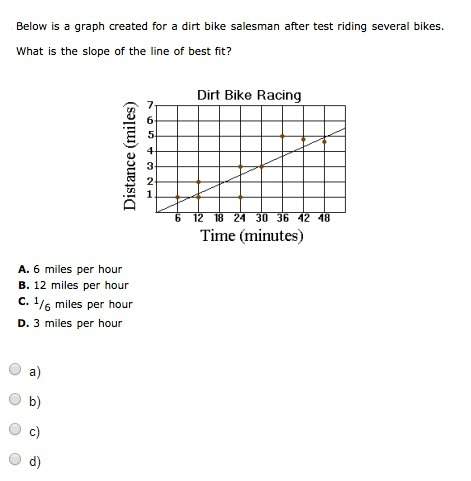
Mathematics, 30.10.2020 20:50, mraymundo025p0gpw9
Check your prediction in part B by graphing the relationship. Go to your Math Tools and open the Graph. Follow these steps to create your graph: Click +DATA and type 0 in the x-column and 0 in the y-column to set the origin of your graph. Then, enter values for length and width of each TV screen in the correct cells in the table. Click PLOT to see the graph of your points. Click +RELATIONSHIP and click LINEAR. Then, check the box for Best Fit. This passes a line through the points you created. Should you make a mistake, click the X next to Data Points to start over. You should now see a graph of the points in the relationship. When you you’re satisfied with the graph, take a screen capture of it and paste it in the answer field. Length (inches) Width (inches) 16 9 20 11.25 24 13.50

Answers: 2
Other questions on the subject: Mathematics

Mathematics, 21.06.2019 17:00, emmaline11
Acertain population of bacteria demonstrates exponential growth doubles in size every 4 days. how long will it take the population to triple in size?
Answers: 1

Mathematics, 21.06.2019 20:30, ElegantEmerald
A. plot the data for the functions f(x) and g(x) on a grid and connect the points. x -2 -1 0 1 2 f(x) 1/9 1/3 1 3 9 x -2 -1 0 1 2 g(x) -4 -2 0 2 4 b. which function could be described as exponential and which as linear? explain. c. if the functions continue with the same pattern, will the function values ever be equal? if so, give estimates for the value of x that will make the function values equals. if not, explain why the function values will never be equal.
Answers: 3

Mathematics, 22.06.2019 01:10, mawawakaiii
Write each improper fraction as a mixed number. 9/4. 8/3. 23/6. 11/2. 17/5. 15/8. 33/10. 29/12.
Answers: 2

Mathematics, 22.06.2019 03:00, TheOriginalMeyah
The biologist has a second culture to examine. she knows that the population of the culture doubles every 15 minutes. after 1 hour and 15 minutes, her assistant found that 80,000 bacteria were present. a) what was the size of the initial population? b) predict the size of the culture at t=3 hours. what was the size of the population at 40 minutes? explain and justify your answers. c) create a graph of the population as a function of time. find an equation that can be used to predict the size of the population at any time t. d) examine the rate at which the bacteria culture is growing. how fast is the culture growing after 1 hour? after 1.5 hours? after 2 hours? use a time interval of h = 0.01 hours to estimate these rates. interpret these rates in terms of the context of the problem situation. how do these three rates compare?
Answers: 1
Do you know the correct answer?
Check your prediction in part B by graphing the relationship. Go to your Math Tools and open the Gra...
Questions in other subjects:



Physics, 18.02.2020 22:17






Spanish, 18.02.2020 22:22

Computers and Technology, 18.02.2020 22:22







